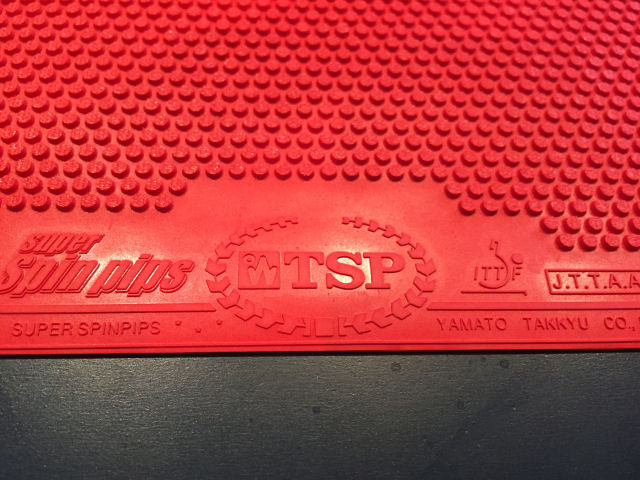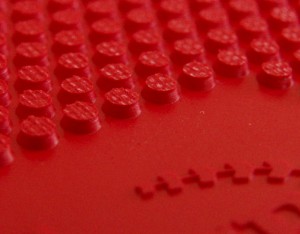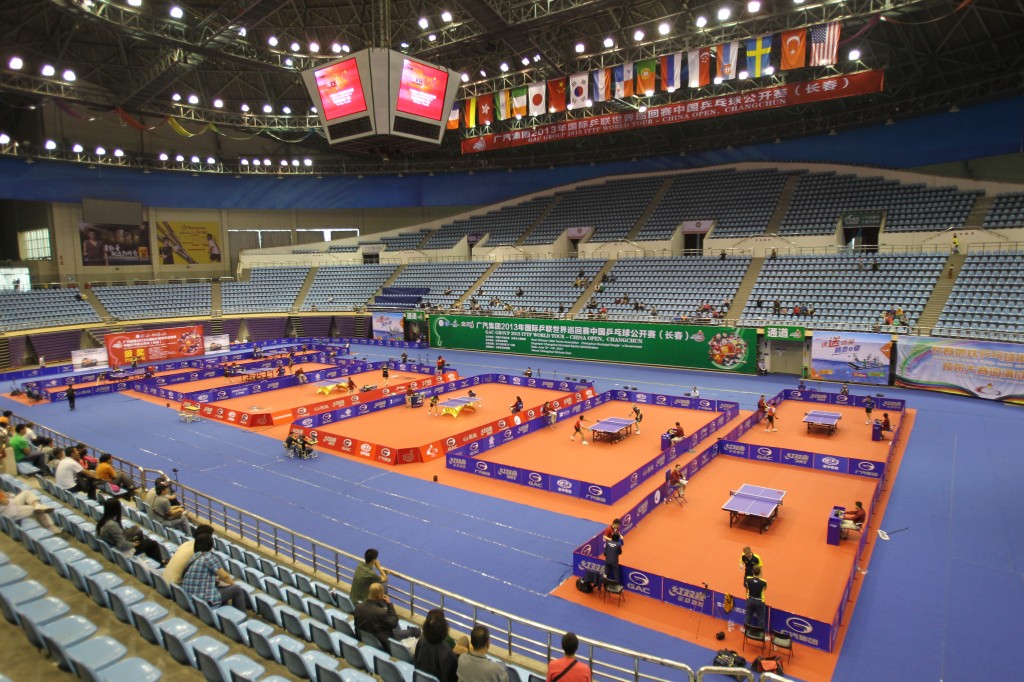
A detailed review of the TSP Super Spinpips rubber, a high grip short pimple rubber allowing you to spin the ball almost like inverted rubbers, but still give you the advantages that short pimples offer. Also a comparison to the popular TSP Spectol is included.
Below is a review and comparison from my friend Beta from OOAK table tennis forum, published with permission and thanks!
 Description from the manufacturer TSP:
Description from the manufacturer TSP:
TSP Super Spinpips is a newly designed pimple out rubber. It has retained all the essential playing characteristics of the original Spinpips rubbers. It provides excellent speed and an amazing long pimple effect. The interplay of these attributions has made Spinpips so popular at international events. Super Spinpips has a unique top sheet and an elastic sponge. This combination produces a powerful top-spin and a fine balance of speed and control. Super Spinpips has effectively more speed and control than the original Spinpips.
Characteristics:
-
Speed: 9.00
-
Spin: 8.25
-
Sponge: 35deg
-
Sponge Colour: Orange
-
Made in Japan
Review by Beta (published with permission and thanks!)
This is one of my new favorite Short Pimple (SP) from my single favorite pip-out manufacturer, TSP. I got the 2.0mm, due to my previous experience of TSP Spectol feeling too thin in 1.8 and too thick in 2.2. If only they made Spectol in 2.0mm too. I don’t see why not, seeing as they did for Wang Tao. Anyway, onto the review.
The look:
More opaque and unimpressive than any TSP pip I’ve ever seen! It rivals Chinese-pip cheapness in looks, to the point that it even looks like the mold used to cast the pips looks like it was very slightly overfilled… while all the pips are flat on top and more or less the same shape, some of the tops are slightly wider than others in a way that could not be intentional. Looks like a version of 802-40 with even lower quality control. What I love about it, however, is the slightly conical shape that the pips have (the quality that made the original Spinpips so amazing). because of the wider base and narrower tip, the sides of the pips can grip the ball to maximum potential on spin shots, but still deliver a perfectly flat (SP) shot on flat shots that only involve the tip of the pips hitting the back of the ball.
The feel:
Semi-soft semi-firm rubber comprising the topsheet. Amazing spin potential for a SP rubber, without excessive spin sensitivity. Again, this depends on where the ball is struck; if you block loops flat it gives a very user-friendly SP-effect block (but nothing like the truly non-spinny pips), while incorporating the sides of the pips gives you control over imparting spin onto the ball. The sponge for this is Perfect. Somehow, TSP has managed to create yet another sponge on par with Spectol, which is undeniably one of the best sponges for a SP rubber out there. (Wang Tao, Hou Yingchao, and Tan Ruiwu couldn’t all be wrong, right?). Very soft, allowing exceptional control on blocks and SP-topspin-drives, yet JUST hard enough to achieve good flat hits (something that I could never do as well with TSP’s 21 sponge).
The throw angle:
Medium for a SP, which, the more I play with, the more I come to appreciate. A low-throw SP is the most straight-shooting and easiest to block with, however a throw just slightly higher than low provides one with many more attacking options, provided they have good enough control on blocks to keep opponents’ high-spin shots on the table. Super Spinpips balanced throw angle and trajectory-length perfectly, giving a very high landing percentage on your shots, and allowing you a greater arsenal of shots, from pretty solid opening loops against backspin, to driving anything from completely dead relatively low balls to high-spin loops.
Against chop:
This is the business. Never have I used an SP that could do BOTH hitting through of backspin or looping it with significant topspin with such ease. Again, I attribute this to the conical shape of the pips. A+, TSP.
Serves:
Remember Liu Guoliang? Remember his serves? Okay, so I can’t serve as well as him, not even close. But the point is this; very, very easy to change your point of contact on the rubber (side of pips or top of pips) to produce what your opponent would perceive as the same stroke, while producing wildly different spin/no-spin variations. The strongest serving SP I’ve ever used, hands down.
Against Topspin balls:
Here’s where it takes a little more skill, and a little more Johnny-Huang’ing of the stroke to be successful. This is not Zhan Jian’s Short pip; if you use little-to-no stroke and slap every ball, you’ll invariably hit a lot of seriously heavy loops from your opponent well off the other end of his side of the table. Given the softness of the sponge and the spin-potential of the topsheet, you can imagine that this isn’t the least-sensitive-to-topspin rubber out there. So think of the stroke like half-way between inverted and SP. Start higher and finish lower than an inverted loop stroke, but still maintain the right-to-left, down-to-up, 45 degree angle stroke of a Real stroke. Digging into the ball like this provides enough friction to counter the opponents topspin and prevent your shot from going off the table, while at the same time making your return fairly dead and allowing you high accuracy for placement on your return. Anyone serious about playing SPs on both sides should study Johnny Huang like the bible, and really get into making a Full SP Stroke with their forehand and backhand. [If you’re only an SP backhand player, the whole game and strategy is entirely different, so I wouldn’t say this philosophy applies. When I played SP BH Inv FH, my SP backhand was best used place-blocking, punch blocking, and hitting through spin with short wrist snaps, mostly setting up FH loop-kills]
Overall:
A rubber for the SP connoisseur. One who doesn’t know a lot about SPs or how to execute a stroke properly with a spinny, soft-sponged SP would hate this, and would be better off going with Haifu Dolphin or RITC 802 (boosted) for polyball slapping. However, the Johnny Huang enthusiast would and should crave this rubber, I highly recommend it. If you aren’t playing in ITTF tournaments, boosting would help a great deal in bringing this rubber to its full potential, but I haven’t boosted it thus far and I still love it.
Follow the discussion and further information on OOAK Forum here.
Comparison to TSP Spectol
 Spectol is perhaps the best all-around pip currently on the market. People often fall for the fallacy that ‘new technology’ makes for the best equipment, but Spectol in itself proves that assertion completely wrong, being decades old and still beating out today’s competition.
Spectol is perhaps the best all-around pip currently on the market. People often fall for the fallacy that ‘new technology’ makes for the best equipment, but Spectol in itself proves that assertion completely wrong, being decades old and still beating out today’s competition.
Spectol’s pips are not at all conical and are semi-glossy, as opposed to the untreated look of Chinese pips, and are very small relative to all pips on the market. While they don’t have the unique effects of the conical pips of Super Spinpips, they are smaller and more flexible, while being equally clustered (meaning that there is more room between the pips as opposed to Super Spinpips or 802-40, because the pips are smaller), which gives them perhaps the most superior feel and control in passive/active blocking, and most definitely chopping.
Something like Super Spinpips is something I would recommend only to those who play it with penhold FH, or SP FH (best combined with SP BH) with shakehand. The reason being, the variation in shots is useful when you can set up the right follow-up shots to make the most of it. Where it most lacks is in the passive or out-of-position blocking, and even when active blocking, does not produce as powerful a block as a pip like Spectol. That of course being because of its inherent capability for spin variation; you must be in control of the pip to use it to your advantage. This makes it especially suspect for chopping, and while I know TSP has manufactured a Super Spinpips with chop sponge (which I haven’t tried), the topsheet indicates that it would be less reliable for controlled manipulation of shots under the duress of facing heavy loops and drives.
Spectol, while slightly more spin insensitive, can produce immense spin against topspin, dead balls, or even backspin. (This is a separate future post, but to sum it up, short pips can produce heavier spin than even inverted rubber if used properly, because the ball does not ‘catch’ on the rubber and get propelled forward; all the forward momentum is created by the user, as is all of the spin. So a short, extremely heavy chop will travel a lesser distance and with lesser pace across the table, therefore requiring your opponent to apply more of their own force to return the ball back onto your side.) The control of Spectol in defensive shots, as well as in flat-hit aggressive shots, far outweighs that of Super Spinpips.
Super Spinpips most excels being used extremely close to the table (preferably on both sides, or if you must, LP on backhand), because of its incredible short game variation, and its greater potential for a wider variety of aggressive shots able to be employed to finish off a point, or at least stay on the offensive. Anything passive, defensive, or crucially counter-play (which most closely treads the line of offense and defense, and is therefore important to mention) is much better served with Spectol.
When I play with inverted on the forehand, these days Spectol is my first choice, due to its ability to counterdrive loops close to the table, and allow my backhand to be passive so that I can focus my energy on stepping around to take 80%+ of shots with my forehand.
Addendum in regards to Spectol:
I play with Spectol on the backhand of OFF to OFF+ composite blades, and can beat most players under 1850 USATT playing as a chopper, which I’m not very good at at all and rarely practice. Keep in mind these blades are looping blades, fast as all hell, and not at all conducive to a defensive game. Spectol in 1.8mm with its regular sponge has to be the best BH chopper rubber I’ve ever tried (I’ve tried countless SP and LP testing this purpose), because of its relative ease of chopping combined with its potential for variation away from the table, and its passive or aggressive potential close to the table.
The full range of TSP pimple rubbers and other products can be found in OOAK Table Tennis Shop, the Australian TSP Distributor.




hi BETA ,thanks for your good review.i am a two wing lopper /smasher.for some reason , i tried SP rubber specially TSP spectol.but with many blade such as clipper or even slower full wood blades,ball speed was too much .when i block or simply drive the boll on my opponent’s loop, my ball will go out of table with under spin . what is the problem? i use wrong technique against loop or the blades are not proper? thank you.
Very good and enlightened review, congratulations and thanks a lot ! Those who truly know short pimples aren’t many out there (as most players are convinced short pimps can’t put much spin, until they play against a SP chopper).
Anyway, I am a chopper and I am currently using Friendship 802 1.5mm, export version (with a quite hard sponge, compared to the original Spectol I used to have). I can put a tremendous backspin with my 802, although it does require physical effort and skills ; I used to play with Spectol 1.5mm before, and found after a few tryings that the 802 was more effective for creating backspin on its own.
What now I want to ask you, since I have read your review, if you recomment me sticking to Spectol 1.8mm ? I am aware that players such as my idol Hou Yingchao are using Spectol, and now I am considering if the thickness of the Spectol would be the key factor. I have never tried Spectol other than in 1.5mm ; are you able to tell me what difference would it make in 1.8mm for chopping ?
Thank you very much for your attention and I am looking forward for your next review here !
Cheers,
Daniel Loureiro
Hi Daniel,
Thanks for your comment.
The short answer is, Spectol in 1.8mm would, as you expect, allow you to create more backspin (a significant amount more, surprisingly) than Spectol in 1.5mm. It would also of course increase the speed of your chops a little, but Spectol is not a fast rubber as it is, so unless you’re boosting it you should have no problem with the speed.
While the 802’s topsheet can create more spin than Spectol’s, Spectol’s softer sponge allows you more control. More control means greater ease of variation (especially on emergency shots), which everyone knows is priority #1 for a chopper.
Regards,
Beta